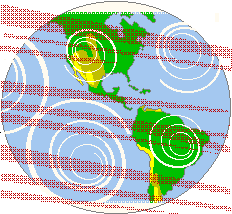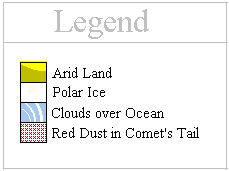
| |
 |
![]()


The Earth slows in its rotation, and actually stops. This is recorded in written history and spoken folklore, worldwide, as a long day or night. The period of time, due to the lack of mechanical clocks, was not measurable, but the humans who experienced this described this as anywhere from a few hours to several days. The latter is more correct. Rotation stops with a predictable part of the Earth facing the approaching 12th Planet - the mid-Atlantic Ocean off the eastern seaboard of the United States. This part of the globe lines up over former lava flows from the renting apart of the continents, the mid-Atlantic rift. Thus, the Atlantic lava beds are gripped, facing the Sun, facing the approaching 12th Planet coming up from the South along the rift, and causing both Europe, the Americas, and Africa to be on the long day side of the Earth. This slowing of rotation occurs with little trauma.
[A] story is told about Joshua ben Num who, when pursuing the Canaanite kings at Beth-horon, implored the sun and the moon to stand still. Joshua (10:12-13):
And the sun stood still, and the moon stayed, until the people had avenged themselves upon their enemies. Is it not written in the book of Jasher? So the sun stood still in the midst of heaven, and hasted not to go down about a whole day.
The Book of Joshua, compiled from the more ancient Book of Jasher, states that the sun stood still over Gibeon and the moon over the valley of Ajalon. This description of the position of the luminaries implies that the sun was in the forenoon position. The Book of Joshua says that the luminaries stood in the midst of the sky. Allowing for the difference in longitude, it must have been early morning or night in the Western Hemisphere.
We go to the shelf where stand books with the historical traditions of the aborigines of Central America. The sailors of Columbus and Cortes, arriving in America, found there literate peoples who had books of their own. In the Mexican Annals of Cuauhtitlan, written in Nahua-Indian, it is related that during a cosmic catastrophe that occurred in the remote past, the night did not end for a long time.
Sahagun, the Spanish savant who came to America a generation after Columbus and gathered the traditions of the aborigines, wrote that at the time of one cosmic catastrophe the sun rose only a little way over the horizon and remained there without moving. The moon also stood still. The biblical stories were not know to the aborigines. Also, the tradition preserved by Sahagun bears no trace of having been introduced by the missionaries.
If the Guides are correct .. the survivors of the axial shift .. will number in the millions, rather than the billions. ... The shift will have its warnings. The weather will become increasingly violent. Eruptions of ancient volcanoes, earth tremors of major proportions, and tidal waves of monumental scope. ... Some will recognize this as the time to remove themselves from the seacoasts. Some will remain, disbelieving that a shift will occur, and some will refuse to leave their homes.
When one wakes up in the morning, finding it to be dark outside rather than a breaking dawn, yet the clocks in the house and the entire neighborhood confirm that it is indeed the morning hour - this is a countdown sign. Rotation will completely stop in a day or so, with such a dawn followed by an evening where the Sun seems reluctant to set, setting hours later than usual, and then rotation stops completely.
A second countdown sign is a fine red dust, unmistakable as it cannot be confused with any other natural occurrence. Ponds and rivers turn red, the blood color mentioned in the Bible's book of Revelations, with this iron ore dust that gives the water a brackish taste. This countdown sign comes almost in step with the rapid slowing in rotation, as the 12th Planet must be between the Earth and the Sun for the trash in its tail to be sweeping the Earth. Again, this occurs a day or so before rotation stops, and travel will become difficult if not impossible once it does.
Where coming late, for primitive peoples without mechanical clocks there is a third countdown sign that can be scarcely ignored. The Earth moans, during her rotation slowing and stoppage, a sound not heard by humans except during earthquakes. Here, the moaning is chronic, essentially continuous, as though under a stress it cannot relieve with an earthquake, yet cannot bear in silence.
In the middle of the second millennium before the present era [approximately 3,500 years ago], the earth underwent one of the greatest catastrophes in its history. A celestial body ... came very close to the earth. The account of this catastrophe can be reconstructed from evidence supplied by a large number of documents. The comet .. touched the earth first with it's gaseous tail. .. Servius wrote, "It was not of a flaming but of a bloody redness."
One of the first visible signs of this encounter was the reddening of the earth's surface by a fine dust of rusty pigment. In sea, lake, and river this pigment gave a bloody coloring to the water. Because of these particles of ferruginous or other soluble pigment, the world turned red.
The Manuscript Quiche of the Mayas tells that in the Western Hemisphere, in the days of a great cataclysm, when the earth quaked and the sun's motion was interrupted, the water in the rivers turned to blood.
Ipuwer, the Egyptian eyewitness to the catastrophe, wrote his lament on papyrus, "The river is blood", and this corresponds with the Book of Exodus 7:20: "All the waters that were in the river were turned to blood".
The tail of the comet is composed of lighter material toward the tip, as any heavier substances that far from the great comet's gravitational influence are drawn in other directions at one point or another. Thus, the gases and dust curl toward the Earth, and are first noticeable as a fine red iron dust, turning the water a bitter blood red. Does this dust not burn in the available oxygen, and end as so many tiny flying star specs? This dust, already oxygenated, does not burn. Its passage is swift, a matter of days, and the ending abrupt.